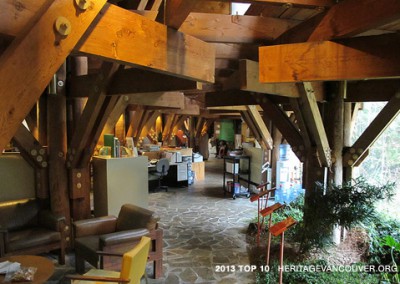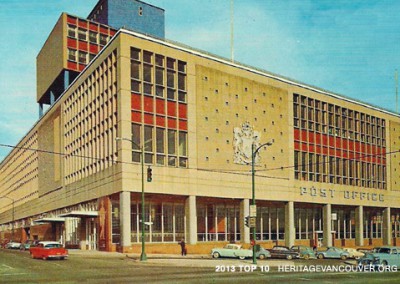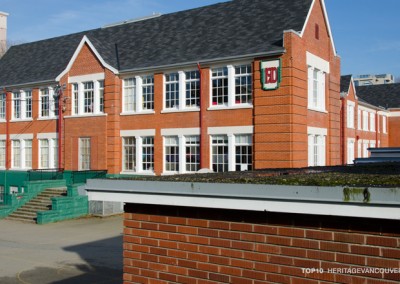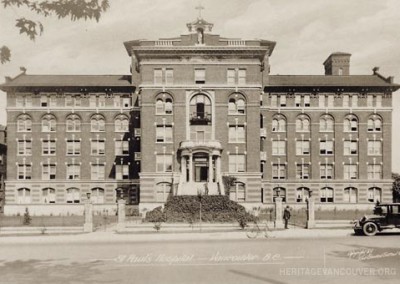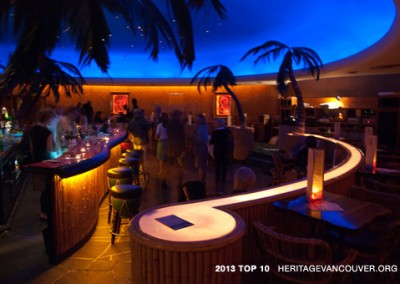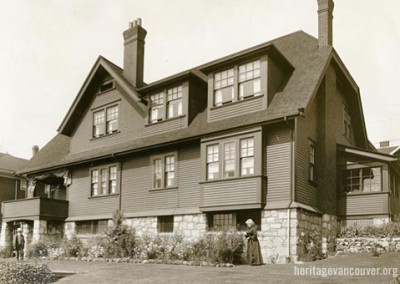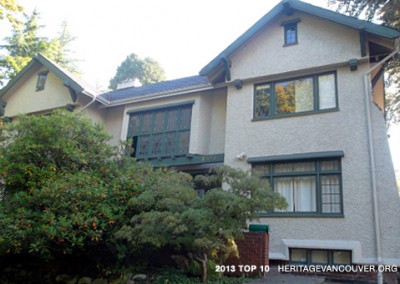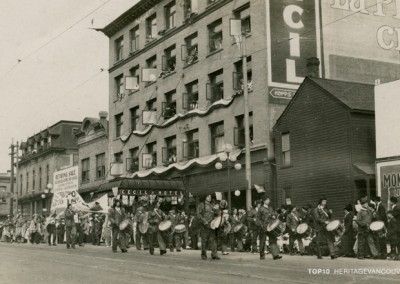With more than 25 development projects undertaken or in the process of being completed, the East Hastings Corridor has experienced immense development pressure. A number of specific properties of heritage interest, most notably the Waldorf Hotel, remain unprotected along this rapidly changing Corridor. More critically, the diverse neighbourhoods surrounding the Corridor will soon face similar stresses. The area is at a turning point where its heritage character will be “let go” unless new civic policies are put in place to protect this area.
Threat
What is the threat to the East Hastings Corridor?
The East Hastings Corridor stretches from Carrall Street well into Burnaby. Our assessment of threat focuses on the portion of the Corridor between Carrall Street and Renfrew Street. A walk down this potentially vibrant street starts with the social housing of the downtown Eastside. It brushes Strathcona and the mixed industrial/commercial zone around the historic site of the Hastings Mill.
Passing the heritage hotspot of the Waldorf Hotel, the Corridor changes character to the main shopping street of the Hasting-Sunrise neighbourhood, an increasingly popular working class community composed of low-rise storefronts surrounded by Vancouver specials and a large number of heritage-worthy homes.
Approaching Renfrew Street, the urban fabric becomes one of mature strip malls ending with the definitive edge of the Hastings Racecourse and the Pacific National Exhibition.
Over the last few years, the many development projects along the street have ranged from high-profile developments with hip-sounding names like La Boheme or The Alba, to more modest multi-storey condominiums placed on top of standardized commercial storefronts. In some cases, most notably the recent acquisition of the Waldorf Hotel site by the Solterra Development Group, these development plans may directly impact recognized heritage assets. These assets are not often listed on the Heritage Register, and are largely unprotected by the City of Vancouver’s Heritage Program.
In other cases, cheaply built developments have replaced the Corridor’s rich fabric of quirky storefronts or job-creating light industrial workshops. In either situation, Vancouver’s least developed streetcar village “High Street” has come under enormous pressure. The East Hastings Corridor requires leadership and vision from the City of Vancouver to guide its transformation in a way that both respects the existing streetscape and specific heritage assets while facilitating the redevelopment of low-quality building stock.
Significance
Why is the East Hasting Corridor significant?
The East Hastings Corridor could be the flagship for an updated and refreshed Heritage Registry and legal protection framework. As a glance at the attached map demonstrates, sections of the Corridor are totally blank in terms of heritage recognition and protection. Yet these sections still retain unusual and sometimes unique heritage assets, both from a specific building perspective as well as a more general notion of the value of a neighbourhood’s character.
Specific examples of properties from the Corridor that could be included in a revitalized heritage protection framework might include:
- Pat’s Pub (403 E. Hastings St) (1914), one of Vancouver’s oldest live music venues and a historic centre for Vancouver’s Jazz scene.
- Ted Harris Paints (757 E. Hastings Street) (1910), a nine decade-old neighbourhood landmark, particularly known for its postwar neon sign.
- The Astoria, (769 E. Hastings Street) a historic bar and hotel and critical part of Vancouver’s live music infrastructure.
- Gulf+Fraser Financial, (803 E. Hastings Street) an attractive modernist commercial building with historic links to industrial waterfront community.
- Waldorf Hotel, (1489 E Hastings Street) (1948, 1955) one of North America’s last intact Tiki Bars.
- The Three Halfies (1768, 1756, 1736 E. Hastings Street) (circa 1940s), a set of Quonset hut style half-moon structures unique to the Corridor.
- The Value Village Building, (1820 E. Hastings Street) an interestingly transparent modernist structure.
- Star Tile, (2121 E. Hastings Street) (1964) with its unique ceramic tile facades
- Dayton Boots (2250 E. Hastings Street) (1946), a historic Vancouver shop and boot maker
The loss of these important cultural or architectural moments in favour of anonymous three-storey apartments would impoverish the urban fabric of the East Hastings Corridor as well as the city as a whole.
Equally critically, the leafy residential blocks surrounding the Corridor will come under redevelopment pressure as East Hastings Street densifies. This will be particularly evident in the Grandview-Woodland neighbourhood where a significant number of homes that are more than 100 years old are already being revitalized or subdivided. As this pressure moves east, entire blocks of Vancouver Specials will become threatened. The Vancouver Special has historically been derided as charmless or common, yet it possesses a significant role in the story of Vancouver housing that deserves recognition. In recent years, the “Special” has been demonstrated to be imminently suitable for adaptive reuse as multi-family dwellings, and could form one part of an effective low-impact densification strategy. Both older and new heritage typologies could become threatened as the East Hastings Corridor is densified and redeveloped.
As the transitional edge between the residential zones of the south and more industrial areas to the north, the Corridor suffers from a strangely split personality. It is the northern border of no fewer than three community planning areas, two of which are currently under review, and as a consequence is frequently overlooked as a critical part of a potentially vibrant revitalization of East Vancouver. Multiple zoning districts exist on neighbouring blocks and in some cases adjacent properties. The Corridor cuts through multiple socio-economic, cultural and ethnic communities, further complicating an inclusive and responsible planning process.
The mixed nature of the Corridor’s zoning means that many development projects will have to undergo a rezoning process to achieve their goals; this gives the City leverage to ensure the protection of potential heritage assets using the traditional heritage revitalization agreement framework as well as the opportunity to test out new policy tools to retain these assets.
Position
Heritage Vancouver’s position
The East Hastings Corridor represents an opportunity for the city to update its Heritage Registry as well as employ new policy tools to encourage heritage retention and adaptive reuse of existing buildings while simultaneously facilitating intelligent densification and development strategies.
A comprehensive heritage strategy for the East Hastings Corridor remains difficult due to the various community planning areas, a multiplicity of overlapping land uses and the fact it is one of the few remaining corridors in the Vancouver area that possesses a significant stock of low-cost property. However, these issues could be addressed by a revamped Heritage Registry and protection framework that would include specific properties on the Registry, and also explore policy initiatives that have proven effective in other jurisdictions. Some examples of these might include property tax incentives for heritage retention and adaptive reuse of existing buildings, or a streamlined planning approval process.
Specifically, we call on for the City of Vancouver to:
- Update the Heritage Registry in a comprehensive manner to reflect new definitions of heritage in terms of cultural assets, urban fabric and neighbourhood character.
- Investigate and incorporate current best practices in terms of heritage retention and adaptive reuse into City policy in order to promote rich vibrant neighbourhoods that include all types and ages of buildings.
- Create a clear definition of the East Hastings Corridor that recognizes the historic connections between neighbourhoods located to the north and south sides of the Corridor.
- Extend RT-3 Zoning to protect existing heritage housing stock north of Hastings in the same way it does in south of Hastings, particularly in the Strathcona area.
- Designate specific properties along the Corridor as significant heritage assets in order to serve as anchors to the Corridor’s history and significance, and leverage the rezoning process to ensure they remain to ensure there are sufficient heritage incentives available.
- Maintain a mixture of residential, industrial and commercial uses to reflect the area’s rich and varied history.


